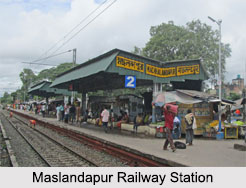 The town of Maslandapur is located over 50 miles from the city of Kolkata and is less than 15 miles from the border between India and Bangladesh. Located at an elevation of 11 metres, Maslandapur is a part of the Habra I CD Block in the Barasat sadar sub division. Maslandpur along with Nokpul, Sadpur and Betuli form a cluster of census towns to the south of the town Gobardanga. The Jamuna River separates the Gobardanga from this cluster. The town of Maslandapur is under the jurisdiction of the Habra police.
The town of Maslandapur is located over 50 miles from the city of Kolkata and is less than 15 miles from the border between India and Bangladesh. Located at an elevation of 11 metres, Maslandapur is a part of the Habra I CD Block in the Barasat sadar sub division. Maslandpur along with Nokpul, Sadpur and Betuli form a cluster of census towns to the south of the town Gobardanga. The Jamuna River separates the Gobardanga from this cluster. The town of Maslandapur is under the jurisdiction of the Habra police.
Demographics of Masalandapur
As per the reports of the Census India 2011, the total population of Maslandapur is 10,790, out of which 51% were males and 49% females, which is basically 5,519 number of males and 5,271 females. The population of children between the ages 0 to 6 years is 879. The percentage of literate people in Maslandapur is quite low, whereas the percentage of illiterates is 85.58% of the total population.
Most of the inhabitants of the town earn their livelihood as "other workers", which include office, factory and transport workers, professionals and business people etc. About a total of almost 32 lakh people from all around the city commute to Kolkata daily for work. In the Sealdah-Bangaon section there are 58 trains that carry commuters from 24 railway stations. In the Seadah-Hasnabad sections 32 trains carry commuters from 30 stations.
As per the District Census Handbook 2011, Maslandapur covers a total area of 1.7 sq. km. It has three primary schools, one middle school, one secondary school and one senior secondary school.
Visiting Information on Maslandapur
The town of Maslandapur is located on the State Highway 3 and is part of the Kolkata Suburban Railway system. Maslandapur has its own railway station, which is on the Sealdah-Bongaon train line and is about 53 km from Sealdah. And the Netaji Subhash Chandra Bose International Airport is the nearest to this town.
This article is a stub. You can enrich by adding more information to it. Send your Write Up to [email protected]



















